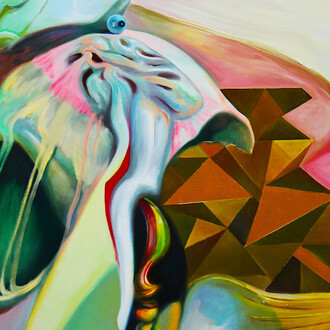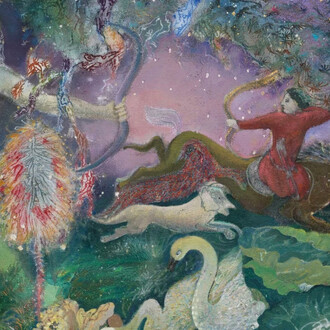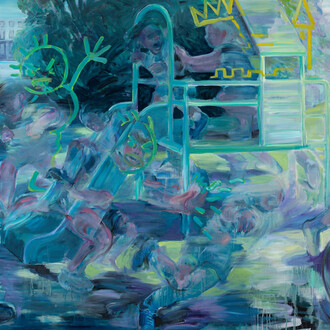The painter Kathleen Jacobs is a member of the ‘reverse Hudson River School’ in having grown up in the American West in Aspen and then living nearby the Hudson River in the East for the last thirty years. She is also a member of a small club of artist/aviators including Doug Wheeler and James Turrell, whose experiences of flying small aircraft have brought them a unique perspective on atmosphere and the aesthetics of the sublime.
Jacobs’ exhibition Woods of symbols is her second at our 26th Street location and features twelve very large paintings laboriously produced in the woods surrounding The mount, the Lenox, Massachusetts home and garden that writer Edith Wharton designed and built for herself in 1902.
The study of clouds, mountains, oceans, and the wind, have a different level of seriousness for an artist/pilot like Jacobs than a regular landscape painter, given the life-threatening potential of those factors to disorient flight. Likewise, Jacobs’ exhausting practice of affixing, painting, and curing large canvases that envelope old growth trees in woods and forests for several years, gives her a heightened sensitivity to the psychological dimensions of forests in the human subconscious. These perceptual and intuited factors are important aspects of Jacobs’ practice.
In 1756 Edmund Burke identified the sublime as the frightening seductiveness of encounters with the overwhelming scale and force of nature, and he noted mankind’s physiological response to the sublime in disrupting normal feelings and perception to provide a bewildering glimpse into the awe of infinite nothingness. Burke comes to mind when considering Jacobs’ experiences of the world sideways and upside-down as an aerobatic pilot, and in confronting the darkness and the unknown while working in the forest.
The skies and the forests in which she finds inspiration remain places of unpredictability, freedom and risk, of enchantment and danger; these haptic sensations feed directly into the disorientating splendor of Jacobs’ work.
Her immersive paintings present elusive and ethereal complex veils of undulating lines that bound semi-transparent layers of color, that age and change as the canvases stretch, age, and evolve in the outdoors. When returned to the studio after several years, the imbedded vertical impressions of tree bark are rotated through 90 degrees to destabilize their vertical orientation and open vistas onto the horizontal plain. After cleaning, preservation of the natural patina, and puncture repairs, the paintings are completed with scumbles of impasto that establish a fore and medium grounds that hover on front of vertiginous pictorial depth.
Accompanying the exhibition is a film by the curator Jérôme Neutres Woods of symbols: Kathleen Jacobs, the title of which is borrowed from Charles Baudelaire. In the poem, Baudelaire describes a journey through a wonderfully resonant and fragrant forest that encapsulates a sense of comfort, sanctuary, and enchantment that captures one half of the psychological paradox of the forest in the human experience and Jacobs’ work.
In Nature’s temple, living pillars rise,
Speaking sometimes in words of abstruse sense;
Man walks through woods of symbols, dark and dense,
Which gaze at him with fond familiar eyes.
Absent however is the potential for menace, confusion, and danger that is at the heart of Burke’s sublime and which finds expression in Alighieri Dante’s first Canto of inferno:
Midway upon the journey of life
I found myself within a forest dark
For the straightforward pathway had been lost
Ah me! how hard a thing it is to say
What was this forest savage, rough, and stern,
Which in the very thought renews the fear.
The solitude, challenge, and supernatural disorientation presented by unspoiled forest attest to mankind’s weakness in the face of nature’s overwhelming power, and that awe and foreboding remain present in woods and forests that surround Jacob’s home and studio.
Voyage and communication between the underworld, the earthly domain, and heavens have been human obsessions since the beginnings of recorded culture, represented in the form of mythical trees of life like Yggdrasil and the flying chariots of Helios; and in establishing her art practice between the forest and the sky, Jacobs extends these ancient traditions in contemporary form.
Jacobs keeps a copy of Antoine de Saint-Exupéry’s 1931 novel Night flight at hand as a guard against complacency in her art and aviation. Saint Exupéry was also a pilot and his words express the intoxicating, confusing, and often tragic visual stimulation that piolets encounter, which ultimately led to the death of his protagonist Fabien:
And now a wonder seized him. Dazzled by that brightness, he had to keep his eyes closed for some seconds. He had never dreamt the night-clouds could dazzle thus. But the full moon and all the constellations were changing them to light…
Now all grew luminous, his hands, his clothes, the wings, and Fabien thought that he was in a limbo of strange magic; for the light did not come down from the stars but welled up from below, from all that snowy whiteness.
Though composed in collaboration with the unpredictability of nature, Jacobs’ paintings share a foundation in the hard geometry of aeronautical navigation. The artist likens the parameters of her canvases to the aeronautical box in which she flies aerobatic patterns. Further, her five letter titles refer to satellite navigation waypoint and fixes for aircraft flying in the clouds or at night, that offer passage to imaginary locations defined by the interception of magnetic vectors drawn from the earth’s poles.
Thus, elements of control and chance are applied in equal measure in conceptual and riveting paintings that are immersive, and receptive to projected thoughts, dreams, and inquiry.
















